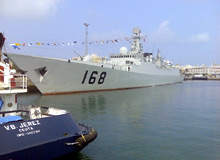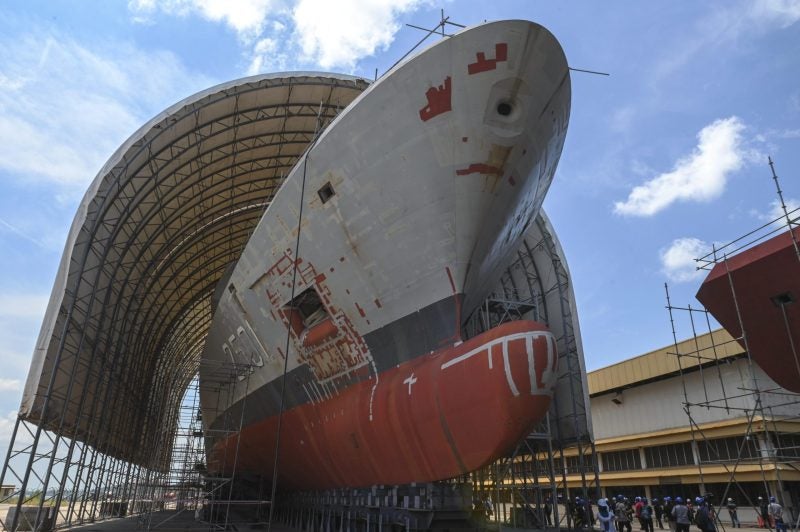
Although the old saying that ‘navy follows trade’ originated in an earlier time, the link between commercial ventures, national interest and naval power continues to be every bit as strong in the opening years of the 21st century.
Historically, this has always marked a division of thinking over the development and deployment of sea-borne forces between countries primarily interested in conquest and dominion, and those with an eye on trade.
From China’s control of traffic across South East Asia throughout the 12th and 13th centuries to the successful raid on the Medway, which established 50 years of Dutch naval supremacy at the end of the 17th century, commerce has repeatedly belonged to those nations willing to flex their naval muscle.
Though the focus may have changed – silk, spice and tea having given way to the ever-growing importance of oil and gas – the rest remains the same. Today, modern naval forces are increasingly being used to protect against threats to national reserves, energy security and commercial interests, with all the resolve of those earlier trading empires.
How well do you really know your competitors?
Access the most comprehensive Company Profiles on the market, powered by GlobalData. Save hours of research. Gain competitive edge.

Thank you!
Your download email will arrive shortly
Not ready to buy yet? Download a free sample
We are confident about the unique quality of our Company Profiles. However, we want you to make the most beneficial decision for your business, so we offer a free sample that you can download by submitting the below form
By GlobalDataFLASHPOINTS AND DISPUTES
See Also:
The reasons for this – and the potential flashpoints – are not hard to see; inevitably in many regions of the world, energy security and national security are intimately connected, particularly when the ownership of local resources is less than clear cut. Around the shores of the Indian Ocean, for instance, 38 countries border a variety of ‘regional’ reserves, with disputed territories exacerbating long-standing feuds in the area.
The East China Sea is another area where oil and gas fields have rekindled old rivalries. Chinese exploration around Chunxiao, Pinghu, Tianwaitian, Duanqiao, Canxue, Baoyunting, Wuyunting and Kongqueting lies close to the median line, which separates the economic territory of China and Japan.
While the Japanese have concerns over the resource exploitation itself – especially the potential for their share to be siphoned off through the field’s continuous underlying geology – they have been equally disquieted over China’s naval presence in the area.
China cannot allow her burgeoning economy to stall, which makes guaranteeing the energy supply a particularly high priority in strategic thinking.
With Chinese estimates of the East China Sea reserves put at around 25 billion tons of oil and 8,400 billion cubic metres of gas, and a national demand predicted to rise to 14 million barrels a day by 2030 – nearly six times the amount for 1989 – the logic is clear.
In recent years, China has been producing new battleships to upgrade its fleet, reflecting, at least in part, a growing understanding of the need to be able to protect offshore sites and vital shipping lanes. The arrival of five Chinese warships – one of them a Russian-built Sovremenny Class missile destroyer – around the Chunxiao site in September 2005 and the reports of one vessel radar locking a Japanese reconnaissance aircraft a few days later, leaves few doubts about their future willingness to do so.
This particular dispute now appears likely to be resolved – an agreement to develop the resources jointly being expected before the summer of 2008. While dialogue and negotiation have succeeded here, the coming years could see the rise of a different kind of strategic alliance – mutable and evolving – where joint venture cooperation is driven by a combination of regional expediency and naval might.
Though this is unlikely to presage a return to the style of gun-boat diplomacy beloved by their colonial predecessors, the global influence of national commercial empires may prove every bit as compelling.
IN COOPERATION AND CONFLICT
There have been signs of regional cooperation between navies to provide protection for the oil industry already. In November 2007, China gave nine patrol boats to Cambodia, in a move widely seen as a strengthening of their military collaboration, following on from the earlier presentation of six similar boats in 2005.
This latest gift comes three months after Cambodia’s announcement of its intention to treble naval personnel numbers to 3,000, and create a new 2,000-strong force of marines to improve offshore security in the wake of expected oil production from undersea reserves. Production may begin as early as 2010, with Chevron drilling more test wells in 2008 and a number of other foreign oil companies have joined the bidding for exploration rights.
Strengthening the navy makes obvious sense; as Lao Mong Hay, head of the legal unit at the Centre for Social Development, points out, jurisdiction over portions of the Gulf of Thailand amounts to very little unless Cambodia has the capability to control those territorial waters. For China, the return lies in gaining a new strategic foothold in Southeast Asia – and in the region’s oil production – which many believe will become increasingly important over the coming years.
The spectre of terrorism has inevitably sharpened thinking on this issue too, the inescapable dependency of the global economy on oil making production facilities increasingly attractive targets – and this is not just an issue for Iraq.
As Justin Blum reported in the Washington Post back in 2004, from Indonesia to Nigeria, attacks on oil and gas operations are seen as a way to ‘disrupt jittery energy markets, destabilise governments and scare off foreign workers’. The task of protecting these installations is a huge one, given the need for ever-vigilant, 24/7 security; the Indian Navy alone is charged with safeguarding 30 process platforms, more than 125 well platforms and over 3,000km of under-water pipelines.
THE CHANGING NAVAL ROLE
Facing such demands, for many countries the nature of naval response has begun to change, both practically in terms of its hardware and institutionally in respect of constitutional and political lines of accountability.
In Australia, for instance, initiatives were implemented in 2005 to strengthen maritime security, focusing in particular on protecting offshore oil and gas facilities, and on ensuring that any terrorist threat to maritime assets could be swiftly detected and neutralised.
However, perhaps the most interesting development was not the expenditure, but the change in lines of command. As a result, the Australian Defence Force assumed direct responsibility for offshore counter-terrorism, including the protection of offshore oil and gas facilities and the interdiction of ships, instead of becoming involved only when called upon by the civil authorities.
The use of naval hardware too has also begun to evolve in this new climate. The US Navy – heavily committed to protecting installations, pipelines and shipping lanes around the globe to ensure the unhindered flow of oil – has responded to the challenge of this added operational dimension with a variety of state-of-the-art technologies.
The use of wide-area sensing and secure communications, coupled with the increased dependence on lighter littoral combat ships has given them a versatile and readily deployable first line of response. Reinforced as required by strike aircraft from traditional battlegroup carriers or ground bases, this new breed can strike with great precision and is also well able to defend itself.
While the situation has not yet reached the level that Michael Klare predicts in his book Blood and Oil, the US military has not been entirely transformed into the world’s oil-protection service – it is clear that it is a role which will become increasingly relevant to many navies.
In 2007, for instance, after a spate of problems at Nigerian oil platforms, NATO announced that it was considering sending forces to protect oil and gas facilities in various parts of the developing world. According to Jamie Shea, director of policy planning at the office of NATO’s secretary general, they are looking very carefully at the use of naval resources and how best to link up with oil companies.
THE SKILLS BONUS
However, the association between the oil and gas industry and the navy is not a one-way street, with increasing numbers of ex-service personnel finding employment offshore as the industry faces a looming skills crisis. The combination of the growing worldwide demand, a workforce approaching retirement – many entered before a period of oil price lows in the 1980s and 90s put the brakes on further recruitment – and a current lack of new entrants has driven global competition for staff.
ex-service personnel find employment offshore as the industry faces a looming skills crisis.”
The need for skilled and experienced workers is most acute, which makes the fit particularly appropriate for naval personnel, their high standard of training, military discipline, proficiency and strong sense of teamwork making them ideally suited to operating in the offshore industry environment.
At a time when global reliance on oil has never been greater, the world has reached a tipping point as the focus of oil production begins to move away from the industrial countries of the northern hemisphere to the emerging nations of the south.
This historic shift also signals a dependence on lands which are often ravaged by conflict, politically unstable and host to rival factions or groups of extremists, where sudden oil wealth often can cause further destabilisation and deepen religious, ethnic and economic divides.
In such a climate, it would seem likely that the world’s naval forces will increasingly be called upon to protect offshore operations in their respective national interest over the years to come.







